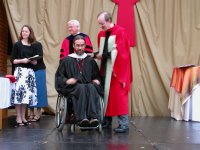
Karen and I got back from
CDSP's baccalaureate and commencement last night, where my Master of Arts. degree was presented. It was for this degree that I wrote my thesis, on Gregory of Nazianzus, which I
defended in September. (Yes, I do expect you all to address me
this way. I may not be clerical, but I might be imperial.)
It's curious to look back at that post about my defense. My future may have been mapless then, but it's not anymore. After almost a year of chaplaincy, Karen and I are now planning to move back to Winnipeg in August. I'm putting in applications at some parishes there, and it feels right. My hope to study in a doctoral program is intact, but the advice to do a few years of parish ministry before further study looks like my best option. I am getting excited about regular preaching, beginning some long-term pastoral relationships in a parish, and continuing to cultivate the friendships we already have in Winnipeg.

It has been a very good week, not just going to Berkeley to graduate, but also to see so many friends, and to have the chance to do some proper good-byes. There are many people that I will miss very much, but proper good-byes are always better than slowly losing touch. As for those we plan to see again, Karen and I have great excuses to visit Baltimore, New York, Boston, and many other places across the continent. I even promised some dogsledding lessons to anyone willing to make the trek north to visit us!
The week has also been one of rest and reflection after my CPE burn-out. I feel like my internal organs have been combusting slowly for about six months. At first I thought it might be ok to live without a kidney, because I do have a second one. And then when my lung went, that was ok too, the other just had to work harder. When my heart caught fire, though, I began to think something could be very wrong.
The combustion was relentless, and it has left me hollow. I feel like skin and bones. So now I'm thinking if they go, I'll be left with nothing - and I'll only be haunting this place, a sleepy and cranky ghost.
Then at baccalaureate we sang "Come down, O Love divine". It left me speechless. We sang
Come down, O love divine,
seek thou this soul of mine,
and visit it with thine own ardor glowing;
O Comforter, draw near,
within my heart appear,
and kindle it, thy holy flame bestowing.
O let it freely burn,
till earthly passions turn
to dust and ashes in its heat consuming;
and let thy glorious light
shine ever on my sight,
and clothe me round, the while my path illuming.
And so the yearning strong,
with which the soul will long,
shall far outpass the power of human telling;
for none can guess its grace,
till Love create a place
wherein the Holy Spirit makes a dwelling.
I was left with a new perspective on my expereience, with special thanks to the author if this hymn, Bianco da Siena. I may feel like this first year out of the seminary been a failure, but I am not without hope. May my burn-out be the purifying fire of the Comforter; may my emptiness make a space within for a new flame, the flame of grace that illuminates my way; and may the hollowing be by the kind of love that makes me a dwelling-place for the Holy Spirit.
Amen and thanks be to God.
Labels: Autobiography








